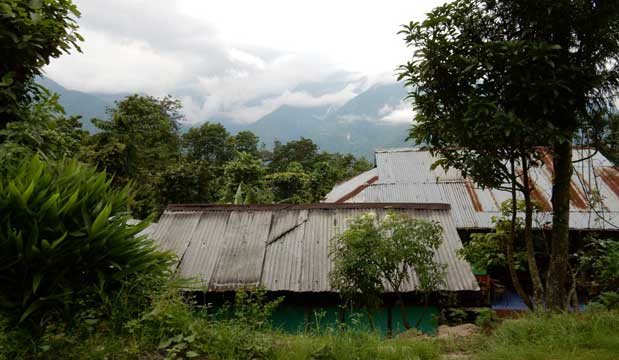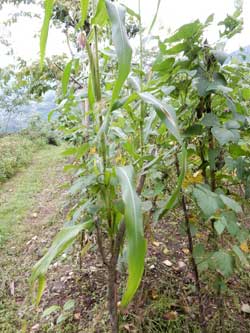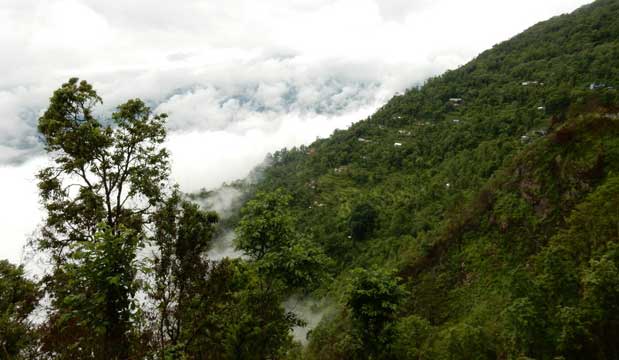BY Harriet-Larrington Spencer, ICIMOD
It is sometimes easy to forget when using the term ‘climate change’ that actual climate change, the real on-ground realities, are locally based and part of smaller scale experiences that make up this larger term. Climatic changes and stressors upon livelihoods are experienced differently by different communities of people, despite their locations within, for example, the same river basin. As a result, adaptation pathways within river basins are also likely to be heterogeneous.
To demonstrate these localised experiences, the Teesta River Basin and two HI-AWARE field sites at different altitudes, are exemplified in this blog. In the two sites, different climatic stressors were identified to be impacting upon livelihoods.
Sakhu-Khani and Uttarey
Sakhu-Khani, in West Pendam, constitutes a mid-hills field site in the HI-AWARE project (photo 1). Livelihoods here consist of sedentary cattle rearing, and the production of maize, ginger and beans. Farmers clubs have been established to sell the milk in urban areas and increasing crop yields were reported by farmers. This is interesting as Sikkim is an ‘organic state’ and improvements were attributed to integrated agricultural practices such as maize-bean intercropping (photo 2). The introduction of a leguminous crop into the maize rotation provides nitrogren, an essential nutrient often depleted in mountain soils.
Uttarey (photo 3) is a small village close to the Sikkim-Nepal border that, at an altitude of around 2,011 metres, is a high-altitude field site. In Uttarey, the main production activity was cardamom monocultulture, with small portions of household land dedicated to the cultivation of vegetable crops, largely for self-consumption.
 Photo 1: Sakhu-Khani
Photo 1: Sakhu-Khani
Climatic stressors for livelihoods
When speaking with both women and men in Sakhu-Khani, we learned that the biggest climatic stressor upon livelihoods was water availability. Although there are natural water sources – small rivers and springs – flow in the lean season is insufficient to support livestock and crop production.
|
Declining availability was attributed to changing precipitation patterns (associated with climate change) in conjunction with increasing population and the development of urban infrastructure. A tangible indication of the declining water availabilty is the conversion from rice cultivation, a high water- requirement crop, to the lower water-requirement crops previously mentioned. Unlike in Sakhu-Khani, people in Uttarey did not identify water problems affecting their livelihoods. Water was plentiful, even in the lean season, in the form of rivers and springs. Instead, all residents with whom I spoke in Uttarey identified increasing solar temperatures as their most critical climatic stressor. This is because the increasing winter temperatures that they are experiencing result in declining winter frosts. These frosts are essential for cardamom production as they kill pests and diseases, thereby preventing the reductions in yields associated with these blights. |
 Photo 2: Maize-bean intercropping in Sakhu-Khani Photo 2: Maize-bean intercropping in Sakhu-Khani |
Adaptations to experienced climatic stressors
People in these areas have adopted different adaptation pathways, based upon localised experiences of climate change in West Pendam and Uttarey. It is important to recognise that within these pathways, in the same locations, there are also differences in the adaptive capacities of different households.
In Sakhu-Khani, a number of adaptation measures are being implemented by households in order to manage the increasing water scarcity that they are experiencing.
 Photo 3: Uttarey
Photo 3: Uttarey
The first is the coordination of the source and use of water. Spring water, considered to be of higher quality than rain or river water, is used predominantly for household purposes, in order to limit the transmission of water-borne diseases. During the monsoon season and when flow is adequate, water is diverted from rivers for agricultural and livestock production.
The second adaptation measure was the implementation of rainwater harvesting during the monsoon, in order to provide water for agriculture and livestock during the lean season. An example of such harvesting is displayed in photo 3. Harvested water is then transported, via pipes, to a larger concrete tank, where it is stored.
 Photo 4: Water harvesting in Sakhu-Khani. Photo 4: Water harvesting in Sakhu-Khani. |
According to people with whom I spoke, the government provides a grant of IRS 10,000 for the construction of storage tanks for the harvested water. However, this is generally insufficient to construct the size of tank required, meaning households also have to invest their own money. Consequently, households with a lower economic status that cannot afford this investment are unable to subsist on agriculture alone during the lean season. During this time, they often undertake paid non-agricultural labour, such as road building. In Uttarey, whilst there is increasing vulnerability in terms of climatic changes for the production of cardamom, there is also a reluctance to move away from its cultivation considering how economically lucrative it is. One adaptation measure identified was livelihood diversification and particularly the emergence of homestays. The region is becoming increasingly popular with tourists – both nationals and non-nationals – who provide an income opportunity. |
However, what I did observe from my brief time in Uttarey is that it seemed to be the more affluent agriculturalists who were establishing homestays.
Considering that their establishment is economically supported by the State Government, it would be interesting to understand further the supportive and preventive factors to their establishment and why there seems to be this difference.
